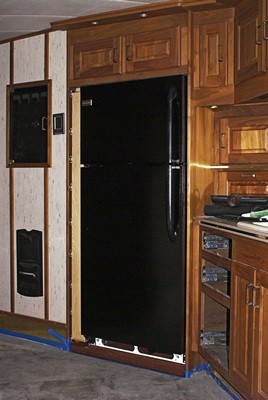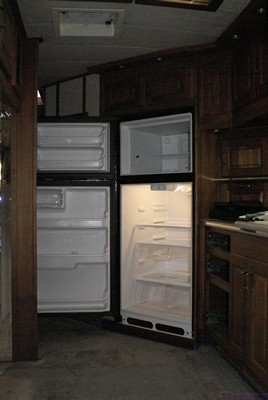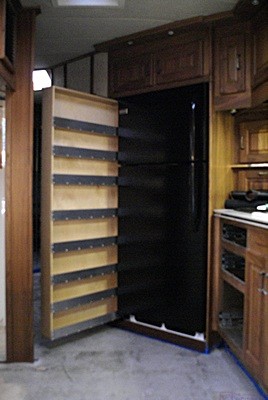Today was windshield day. A week or so ago Chuck made appointments for both us to have windshields replaced on our buses by the local Safelite franchise. Chuck knows Scott, who now has a management position with the company, and arranged the work through him. The appointment was nominally from 8 AM to noon so Chuck was at his shop before 8. We figured it would take a while for the crew to do his two lower windshields so I got up around 7 AM but did not have coffee or breakfast. I finished yesterday’s blog post and then went through my final departure tasks starting at 8:30 AM. I texted Chuck at 8:45 AM and pulled out of our driveway at 8:50 AM, figuring that was late enough to miss most of the morning traffic headed into the northwest corner of the Detroit metropolitan area. Chuck texted back that I could take my time as the crew had not shown up yet.
The first raindrops came as I was pulling out of our driveway. As I pulled out onto Hacker Road I had a clear view of dark clouds to the northwest. Although my destination was 20+ miles to the southeast I headed north towards M-59. The shortest route would have been south, and gotten me quickly onto pavement, but there are some low branches before the road ends at Grand River Avenue so I do not go that way. From Hacker and M-59 the shorter route would have been east to US-23 and then south to I-96 but that interchange is a left exit, left entrance in the middle of an extensive construction zone; not the sort of thing I wanted to deal with in the bus. So I waited patiently for a break in the traffic and then headed west on M-59 towards the storm clouds. A guy heading east had to slow down while I pulled out a flipped me off as he went by. I hope he had a nice day.
I encountered heavier rain as I traveled west for about four miles. I turned south onto Latson Road and drove away from the rain, reaching I-96 about four miles later. I headed east on the I-96 and had an easy drive all the way to Beck Road with only an occasional raindrop. Even at this hour of the morning there were traffic slowdowns along the way but no parking lot traffic jams. The Beck Road exit was easy to navigate going south and it was equally easy to position myself for the left turn onto Grand River Avenue. About a mile and a half later I pulled into the parking lot for Chuck’s shop and phoned Chuck to let him known I was there.
I knew in advance how he wanted me to position my motorcoach but there were enough vehicles parked in various places that I wanted him to spot for me. I lifted the tag axles, pulled up to the building, and then turned hard to the right. I backed around to the driver’s side to get somewhat parallel to the building and then started angling towards the passenger side. There is space next to the building in front of Chuck’s shop directly across from his large (bus size) overhead door. My objective was to back around into that space and then pull forward steering hard to the left to get lined up with the door. I have done this before and managed to do it again with Chuck’s assistance. Our Prevost H3-40 VIP conversion is surprisingly maneuverable with the tag axle lifted off the ground.
There were two Safelite vans there when I arrived and Charlie and Eric were already busy working on Chuck’s lower windshields. Chuck had backed his coach into the shop so I could pull in nose first and get the front end out of the rain if needed. Since there were only two guys, and the removal and installation of one of these windshields is a two man job, I just parked my bus outside and shut it off.
I called Linda at home but did not get her so I tried her cell phone. She was at Kensington Metropark walking with Diane. She said we had heavy rain at home before she left and that it was moving towards the shop. I could see the dark clouds to the WNW and it eventually rained bucketfuls, albeit for only a brief time.
A couple of years ago Chuck and I went together and bought five lower windshields from Prevost for our H3-40 VIP coaches, two for him and three for me, for the ridiculously low price of $125 each. They were shipped to his shop in a big triple set of cardboard boxes with foam spacers on a pallet and have been sitting there waiting for us to find someone to install them. Chuck decided to use both of his, in part because there were stone chips in the current ones, and in part because he is vacating his shop and needed to reduce the amount of stuff that has to be moved and stored.
The existing windshields on Chuck’s coach both cracked rather badly when they were removed, as in multiple dozens of fractures, but did not shatter. Safety glass is a wonderful thing. He was not planning on keeping the old ones but it was obvious that removing a windshield in order to install a new gasket with the idea of reinstalling the glass was probably not possible. Charlie and Eric removed the old gaskets and then cleaned off the frames. Chuck’s old gaskets had been slit at the corners by a previous installer, probably to make it easier to get the gaskets over the glass, but should not have been altered in that way.
Chuck had new gaskets and spline material so the guys got one of the new gaskets installed on the frame. It looked like it would be too big but by the time they got it pressed fully into place it was a perfect fit. They lubricated the gasket and set the new windshield in place. After working the top of the gasket over the top edge of the glass they slid the windshield from the outside edge all the way towards the center pillar.
Chuck and I were both hungry and thirsty. Since Charlie and Eric were working on his coach I took Chuck’s suburban to Panera for coffee, a muffin (for Chuck) and a bagel (for me). I made the trip twice. I was almost there when I realized that I did not have my wallet and went back to get it.
The guys finished installing Chuck’s windshields and went to lunch. We did not leave as we had no idea how long they would be gone. It turned out to be about an hour. When they got back I had Charlie look at my two lower windshields. The passenger side was cracked and definitely needed to be replaced. The driver side had two small rock dings but they were not directly in front of the driver’s seat and not near an edge so I decided to only replace the passenger side lower windshield at this time.
I started up the bus, pulled the nose into the shop, and lowered the suspension to make it easier for the guys to work on it from the outside. I pulled in far enough to make sure the front part of the roof was completely inside the building as it is lower than the rest of the roof and slopes forward. I lowered the rear more than the front to make sure any rain that hit the portion of the roof that was outside the building ran to the sides and rear rather than forward and down the windshields.
To remove my windshield they removed the spline that locks the glass into the gasket and then managed to get the glass and gasket out as one assembly. The glass already had a 10″ crack when they started and was fractured in 100 places by the time it came out. They cleaned off the frame, which had a lot of crud on it, and then put the new gasket on. The gasket for the lower windshields is reversible and is used on either side. It is not rectangular, however, with the vertical edge by the center pillar being longer than outside edge where the glass wraps around into the A pillar.
With the gasket in place they installed the windshield by using large suction cups to pick it up, front and back side, and setting the bottom edge into the gasket with the right edge about four inches from the center pillar. The passenger side mirror was in the way so I had to loosen one of the set screws and swing it out of the way. They used a hard plastic stick with a rounded tip and edges to get the gasket over the outside of the top edge of the glass. Using glass cleaner as a lubricant they then slid the glass towards the center and into the gasket channel. The glass did not slide easily but Charlie and Eric were big, strong guys and it eventually was in place. They then used the plastic sticks to get the gasket out from behind the glass and over the edge all the way around. The last step in the installation was to put Sikaflex adhesive caulk between the frame and the gasket and between the gasket and the glass, all from the outside. They masked off the frame to protect the paint but did not mask off the glass. Gasketed glass installation was not something I knew anything about so it was informative to be able to watch every detail of this process.
They had our invoices with them but had to have the office redo mine and e-mail it since I only had one windshield replaced instead of the two we originally scheduled. Chuck and I each wrote them a check. Eric had us sign on his Note tablet and printed our receipts on a portable wireless printer. It had been six hours since they arrived and they had spent five of those working pretty hard. We gave each of them a $20 tip.
Charlie and Eric loaded up our three old broken windshields and left. I then backed my bus out and parked it. Charlie wanted it to sit for at least an hour before driving it to let the Sikaflex cure a bit. Chuck locked up the shop and we went to Panera (again) for a late lunch. We both had Black Bean Soup and Chuck had a half sandwich. Barb called as we were finishing our meal and said she was her way to the shop so we headed back. She arrived at the shop just ahead of us and inspected the new windshields on their coach. I then showed her the work we have done on the interior of our coach. We sat around in the shop talking while I waited for the worst of the rush hour traffic to pass before driving the bus back to our house.
I called Linda around 5 PM and then left for the drive home, reversing my route from this morning. Traffic was heavy but moved along. Linda heard me pull in the driveway and helped get me positioned. It’s hard to sneak up on someone with a Detroit Diesel 8V92 engine. Once I was parked I shut off the accessory air to the engine bay, disconnected the chassis batteries, and plugged in the electrical shorepower line. Back in the coach I noticed that the refrigerator had come out of the alcove about 12 inches. It had not budged on the drive to/from Edwardsburg and Elkhart but I will obviously have to secure it after all.
Dinner was reheated chili and Saltine crackers. When Linda makes chili she always makes extra and freezes it to have on hand for easy heat and serve meals. It is a one pot meal the way she makes it and is as good, or better, left over as it is fresh.
Ferman had called while I was gone and let Linda know that he had the Sandstone Corian he needed to build the small table for the bus so after dinner I texted Josh to let him know. I then checked e-mail but did not respond to any. We watched NCIS and NCISNOLA on the big TV in the basement and then went to bed.


